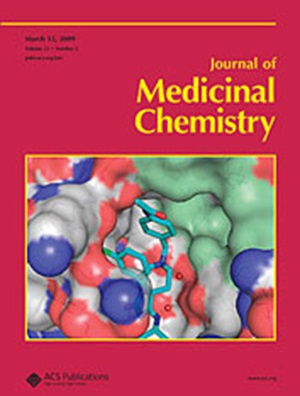发现新的环肽作为治疗肝纤维化的SMAD2-SMAD4相互作用抑制剂
IF 6.8
1区 医学
Q1 CHEMISTRY, MEDICINAL
引用次数: 0
摘要
肝纤维化以细胞外基质过度沉积为特征,是各种慢性肝脏疾病的常见后果。然而,到目前为止,还没有特异性的抗纤维化药物。SMAD2通过转化生长因子-β磷酸化,随后与SMAD4结合产生异质复合物,该复合物随后易位到细胞核并加重肝纤维化。在此,基于分子对接模拟和构效关系研究,我们报告了一种新的环状肽CMF9的发现,它靶向SMAD2并可能干扰SMAD2 - smad4的相互作用。随后的体内和体外药理研究表明,CMF9显著抑制肝星状细胞活化和胶原合成,减轻ccl4诱导的肝脏炎症和纤维化。总体而言,我们首先证明了新型环肽CMF9可以通过选择性抑制SMAD2磷酸化来有效阻断SMAD2 - smad4的相互作用,为靶向SMAD2提供了一种有希望的治疗策略和治疗肝纤维化的替代候选药物。本文章由计算机程序翻译,如有差异,请以英文原文为准。

Discovery of Novel Cyclic Peptides as SMAD2–SMAD4 Interaction Inhibitors for the Treatment of Hepatic Fibrosis
Hepatic fibrosis, characterized by the excessive deposition of the extracellular matrix, represents a common consequence of various chronic liver disorders. However, no specific drugs are available for antifibrotic therapy to date. SMAD2 is phosphorylated by transforming growth factor-β and subsequently binds to SMAD4 to generate a heteromeric complex, which then translocates into the nucleus and aggravates liver fibrosis. Herein, based on molecular docking simulation and structure–activity relationship study, we report the discovery of a novel cyclic peptide CMF9 that targets SMAD2 and potently interferes with the SMAD2–SMAD4 interaction. The subsequent in vivo and in vitro pharmacological studies demonstrated that CMF9 dramatically suppressed hepatic stellate cells activation and collagen synthesis, alleviating CCl4-induced hepatic inflammation and fibrosis. Overall, we first demonstrated that the novel cyclic peptide CMF9 could efficiently block the SMAD2–SMAD4 interaction via selectively inhibiting SMAD2 phosphorylation, providing a promising therapeutic strategy for targeting SMAD2 and an alternative candidate for the treatment of liver fibrosis.
求助全文
通过发布文献求助,成功后即可免费获取论文全文。
去求助
来源期刊

Journal of Medicinal Chemistry
医学-医药化学
CiteScore
4.00
自引率
11.00%
发文量
804
审稿时长
1.9 months
期刊介绍:
The Journal of Medicinal Chemistry is a prestigious biweekly peer-reviewed publication that focuses on the multifaceted field of medicinal chemistry. Since its inception in 1959 as the Journal of Medicinal and Pharmaceutical Chemistry, it has evolved to become a cornerstone in the dissemination of research findings related to the design, synthesis, and development of therapeutic agents.
The Journal of Medicinal Chemistry is recognized for its significant impact in the scientific community, as evidenced by its 2022 impact factor of 7.3. This metric reflects the journal's influence and the importance of its content in shaping the future of drug discovery and development. The journal serves as a vital resource for chemists, pharmacologists, and other researchers interested in the molecular mechanisms of drug action and the optimization of therapeutic compounds.
 求助内容:
求助内容: 应助结果提醒方式:
应助结果提醒方式:


